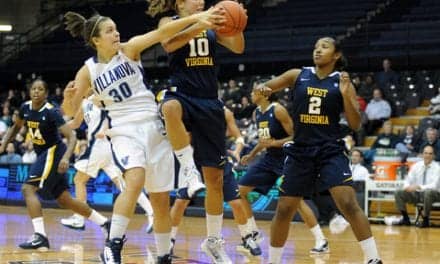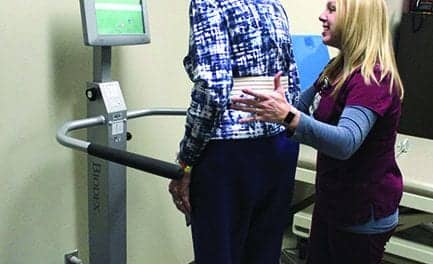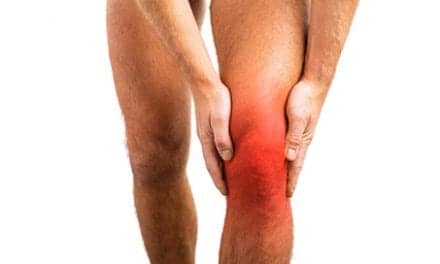Are you staying up to date on post-op knee rehab protocols and surgery techniques, including those for a new implant to repair ACL tears?
By John Gallucci Jr, MS, ATC, PT, DPT
Main Photo: Patient utilizing blood flow restriction therapy for post-op knee rehab. Photo: JAG-ONE Physical Therapy
As a comprehensive outpatient physical therapy company, and a major healthcare resource for the community, JAG-ONE Physical Therapy is always striving to advance our skills and treatment techniques to provide the most up-to-date evidence-based care. The field of physical therapy is ever evolving, as are medicine, surgery techniques, rehabilitation protocols, etc, and we, as an integral piece in post-operative recovery, make it a priority to stay connected with the latest research and newest products for the benefit of our patients and their outcomes. This includes post-op knee rehab.
Total Knee Arthroplasty
Total Knee Arthroplasties (TKAs) are on the rise, with more than 670,000 currently being performed annually in the United States and an expected increase to nearly 3.5 million by 2030.1 TKA is one of many commonly seen surgeries in the outpatient physical therapy world. Typically, TKAs have a straightforward post-op knee rehabilitative process with a quick and easy recovery. Less commonly, you will come across complications such as higher than expected pain levels, severe swelling, joint contracture, or deep vein thrombosis. In these less frequent situations, we continuously re-assess the patient’s status, increase communication with the patient’s family and physicians, and modify our treatment plans.
An initial plan that focuses on frequent icing, early range of motion, and weight bearing activities are critical in achieving early goals and preventing setbacks following total knee arthroplasty. Additionally, education on compliance with a home exercise program and an icing protocol should be a priority, as this can also have a huge impact on pain and swelling management and can prevent complications.
Post-Op Knee Rehab After ACL Reconstruction
The most common ligamentous injury seen at the knee is an anterior cruciate ligament (ACL) tear, with approximately 80,000 to 250,000 injuries seen per year.2 Post-operative rehabilitation after an ACL reconstruction follows a defined protocol with incremental stages addressing range of motion, weight bearing, strength, and functional milestones. It is critical, as the physical therapist, that we educate the patient and closely follow each phase of rehab to prevent any setbacks.
Initial phases will consist of icing often to control swelling and pain, gradual progressive range of motion to prevent contracture and muscle setting to avoid muscle atrophy. As the patient progresses through the phases of rehabilitation, range of motion, strengthening, and functional performance will advance based on the patient’s progress.
Lastly, there will be a big focus on retraining muscles for return to sport. To prevent re-injury, this phase requires attention to detail and additional challenges as patients get closer to a return to higher level activity. In preparation for return to sport, following any knee surgery, it is important to apply very specific tests and measures to confirm that muscle strength, balance, and control are adequate for sport demands. At JAG ONE Physical Therapy, through extensive research, we have formulated a “Lower Extremity Return to Sport Assessment,” which encompasses a variety of objective measurements and functional- and sport-specific movement assessments to best determine safe return to activity.
BEAR Implant for ACL Repair
A more recent advance in orthopedic knee surgery is the Bridge-Enhanced ACL Repair (BEAR) Implant from Miach Orthopaedics Inc, which is an alternative to ACL reconstructive surgery. The BEAR Implant acts as a bridge to help ends of the torn ACL heal together. The surgeon injects a small amount of the patient’s own blood into the implant and inserts it between the torn ends of the ACL in a minimally invasive procedure. The combination of the BEAR Implant and the patient’s blood enables the body to heal the torn ends of the ACL back together while maintaining the ACL’s original attachments to the femur and tibia. As the ACL heals, the BEAR Implant is resorbed by the body, within approximately eight weeks.
There are specific criteria for being a candidate for this surgery. At JAG-ONE Physical Therapy, we have several physical therapists who are certified to rehabilitate patients following the BEAR Implant procedure, which follows a strict protocol.
The protocol includes recommendations for the products and types of treatment physical therapists should use with patients through seven distinct phases over the course of a year. Each phase is defined by specific goals and criteria for progression to the next phase.
Recommendations in the initial stages include crutch use, bracing, range of motion exercises, muscle activation and strengthening, NMES (NeuroMuscular Electrical Stimulation), and cryotherapy. Toward the end of recovery, patients are undergoing advanced training, with goals of mastering running patterns, jumping, and hopping. Recommendations at this point include more advanced strengthening, agility drills, neuromuscular training, and rigorous cardiopulmonary training.

Post-Knee Surgery Physical Therapy Tools
As we can see, it is critical for any physical therapist to have a variety of “tools” in their toolbox to be able to provide comprehensive treatment. In knowing the potential obstacles following any orthopedic surgery, we want to have a wide range of modalities and products to apply to mitigate complications and to ensure a successful outcome. Listed below are a few of our favorite items to include in post-operative physical therapy treatment.
Cold Compression System
In the initial phases of rehabilitation following any knee surgery, our first focus is to reduce pain and swelling. A cold compression system which offers a combination of intermittent compression and cryotherapy can provide therapeutic benefits such as decreased pain, decreased swelling, and increased range of motion.3 This is a great start to rehabilitation following knee surgery.
Weight Supported Treadmill
As we progress through the initial phases of rehabilitation following a knee surgery, we begin to prepare for gait training and functional mobility. Most post-operative knee patients will have been placed in a brace or given an assistive device for the first few days, weeks, or months following surgery. This creates compensations, poor habits, and gait deviations. For a patient to transition to full weight bearing after functioning weight assisted is a challenging task.
To achieve a normalized gait pattern with as little compensatory patterns as possible, the utilization of a body weight supported treadmill is key. This provides the patient the opportunity to begin walking with their weight supported, at varying amounts. The patient can transition through different percentages of body weight working toward full weight and eventually running (if that is their goal). It also gives the patient more confidence and comfort in those initial stages of increasing weight through their surgical knee.
Blood Flow Restriction
The application of blood flow restriction (BFR), in conjunction with strength and functional training, is a great tool to implement in post-operative rehab to advance muscle mass and endurance. BFR is the application of a pneumatic tourniquet cuff to the proximal portion of an extremity which partially impedes blood flow to the limb and in turn increases muscle strength and size.4 We have found that patients enjoy the application of BFR in their post-operative recovery as it gives them an opportunity to perform lifting of lighter loads while still assisting in making the strength gains needed for return to full function and sport.
Functional Dry Needling
Dry needling is a technique that can be performed by physical therapists certified through extensive education and training. It can be applied at any point in the post-operative recovery and has positive impacts on myofascial trigger points and pain level. In reducing muscle tightness and pain, with the utilization of this modality, the patient then can perform their exercise program with improved quality of movement patterns.5 We have found that patients respond well to dry needling with reports of immediate pain relief allowing for increased tolerance with completing their exercise program.

Cupping
Cupping therapy is a great option to incorporate into manual treatment. It is thought that this technique releases soft tissue, drains excess fluids and toxins, loosens adhesions, lifts connective tissues, and brings blood flow to an area of stagnant skin or muscle.6 It is performed with cups made of varying materials such as glass, bamboo, ceramic, or plastic. Therapists apply the cups to the area treated with a firm suction to create a negative pressure. This negative pressure ensures that the superficial layers of skin, or fascia, are elevated to improve circulation. We have found that including this technique, in addition to tissue and joint mobilization, provides the patient with pain relief and improved function.
Isokinetic Testing
Isokinetic testing is a great option for gathering accurate objective measurements following a knee surgery and in preparation for return to function or sport. It can be utilized in the assessment of strength, power, and endurance at any point in the patient’s recovery. This can provide the physical therapist, referring physician, and patient with initial, mid-way, and discharge comparative measurements.
The patient’s muscle performance is challenged while the machine provides continuous resistance through a specific range of motion. Detailed objective measurements are automatically calculated and provided through the machine. Because of the objectivity and reproducibility of the measurements, patients and physicians value the utilization of this piece of equipment as it gives us visibility into safe return to activity and sport.7
Keys to Successful Recovery
As physical therapists, we must remain committed to continuing education to ensure we are well-versed in the most innovative tools utilized to assist our patients in their recovery. It is equally as important to educate our patients and closely monitor their progression to prevent any setbacks and ensure a full recovery.
John Gallucci Jr, MS, ATC, PT, DPT, is president and CEO of JAG-ONE Physical Therapy, which offers 84 comprehensive orthopedic outpatient centers throughout New York, New Jersey, and Pennsylvania. Currently, Gallucci is the medical coordinator for Major League Soccer, coordinating the medical care of over 800 professional soccer players and a sports medicine consultant for professional athletes. He has worked in the athletic departments of Columbia University, New York University, and Long Island University, and has been a clinical instructor at Columbia University, Seton Hall University, Rutgers University, and Dominican College. Gallucci also sits on the governor-appointed New Jersey Council on Physical Fitness and Sports. For more information, contact [email protected].
References
1. King PJT. (2020, June 5). Total Knee Arthroplasty (TKA). APTA. https://www.apta.org/patient-care/evidence-based-practice-resources/clinical-summaries/total-knee-arthroplasty-tka
2. Celebi PKT. (2020, June 5). Anterior Cruciate Ligament (ACL) Injury. APTA. https://www.apta.org/patient-care/evidence-based-practice-resources/clinical-summaries/anterior-cruciate-ligament-acl-injury
3. Sadoghi P, Hasenhütl S, Gruber G, et al. Impact of a new cryotherapy device on early rehabilitation after primary total knee arthroplasty (TKA): a prospective randomised controlled trial. Int Orthop. 2018;42(6):1265-1273. doi:10.1007/s00264-018-3766-5.
4. Perspective: Blood flow restriction, beyond just muscle. APTA. (2021, July 16). Retrieved December 20, 2022, from https://www.apta.org/article/2021/07/16/blood-flow-restriction-beyond-just-muscle
5. McAphee D, Bagwell M, Falsone S. Dry Needling: A Clinical Commentary. Int J Sports Phys Ther. 2022;17(4):551-555. Published 2022 Jun 1. doi:10.26603/001c.35693
6. Thomas K. The Debate about Cupping Therapy. Co-Kinetic Journal. 2022;(91):32-39. Accessed December 20, 2022. https://search.ebscohost.com/login.aspx?direct=true&db=s3h&AN=154410118&site=eds-live
7. Cvjetkovic DD, Bijeljac S, Palija S, Talic G, Radulovic TN, Kosanovic MG, Manojlovic S. Isokinetic Testing in Evaluation Rehabilitation Outcome After ACL Reconstruction. Med Arch. 2015 Feb;69(1):21-3. doi: 10.5455/medarh.2015.69.21-23. Epub 2015 Feb 21. PMID: 25870471; PMCID: PMC4384850.





